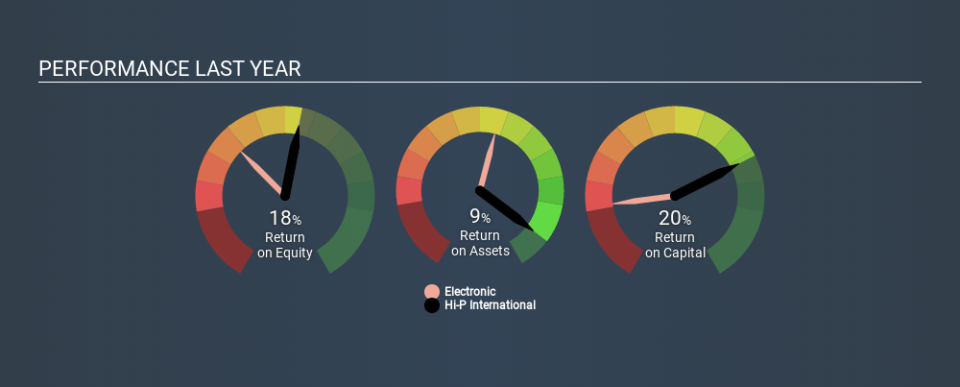A Close Look At Hi-P International Limited’s (SGX:H17) 20% ROCE

Today we'll look at Hi-P International Limited (SGX:H17) and reflect on its potential as an investment. To be precise, we'll consider its Return On Capital Employed (ROCE), as that will inform our view of the quality of the business.
First, we'll go over how we calculate ROCE. Second, we'll look at its ROCE compared to similar companies. Last but not least, we'll look at what impact its current liabilities have on its ROCE.
Return On Capital Employed (ROCE): What is it?
ROCE is a measure of a company's yearly pre-tax profit (its return), relative to the capital employed in the business. In general, businesses with a higher ROCE are usually better quality. Ultimately, it is a useful but imperfect metric. Author Edwin Whiting says to be careful when comparing the ROCE of different businesses, since 'No two businesses are exactly alike.
So, How Do We Calculate ROCE?
Analysts use this formula to calculate return on capital employed:
Return on Capital Employed = Earnings Before Interest and Tax (EBIT) ÷ (Total Assets - Current Liabilities)
Or for Hi-P International:
0.20 = S$118m ÷ (S$1.2b - S$555m) (Based on the trailing twelve months to September 2019.)
So, Hi-P International has an ROCE of 20%.
See our latest analysis for Hi-P International
Is Hi-P International's ROCE Good?
One way to assess ROCE is to compare similar companies. Using our data, we find that Hi-P International's ROCE is meaningfully better than the 11% average in the Electronic industry. We consider this a positive sign, because it suggests it uses capital more efficiently than similar companies. Regardless of where Hi-P International sits next to its industry, its ROCE in absolute terms appears satisfactory, and this company could be worth a closer look.
Our data shows that Hi-P International currently has an ROCE of 20%, compared to its ROCE of 0.3% 3 years ago. This makes us wonder if the company is improving. The image below shows how Hi-P International's ROCE compares to its industry, and you can click it to see more detail on its past growth.
Remember that this metric is backwards looking - it shows what has happened in the past, and does not accurately predict the future. ROCE can be deceptive for cyclical businesses, as returns can look incredible in boom times, and terribly low in downturns. This is because ROCE only looks at one year, instead of considering returns across a whole cycle. What happens in the future is pretty important for investors, so we have prepared a free report on analyst forecasts for Hi-P International.
What Are Current Liabilities, And How Do They Affect Hi-P International's ROCE?
Short term (or current) liabilities, are things like supplier invoices, overdrafts, or tax bills that need to be paid within 12 months. Due to the way ROCE is calculated, a high level of current liabilities makes a company look as though it has less capital employed, and thus can (sometimes unfairly) boost the ROCE. To counteract this, we check if a company has high current liabilities, relative to its total assets.
Hi-P International has total liabilities of S$555m and total assets of S$1.2b. As a result, its current liabilities are equal to approximately 48% of its total assets. Hi-P International has a middling amount of current liabilities, increasing its ROCE somewhat.
Our Take On Hi-P International's ROCE
While its ROCE looks good, it's worth remembering that the current liabilities are making the business look better. There might be better investments than Hi-P International out there, but you will have to work hard to find them . These promising businesses with rapidly growing earnings might be right up your alley.
For those who like to find winning investments this free list of growing companies with recent insider purchasing, could be just the ticket.
If you spot an error that warrants correction, please contact the editor at editorial-team@simplywallst.com. This article by Simply Wall St is general in nature. It does not constitute a recommendation to buy or sell any stock, and does not take account of your objectives, or your financial situation. Simply Wall St has no position in the stocks mentioned.
We aim to bring you long-term focused research analysis driven by fundamental data. Note that our analysis may not factor in the latest price-sensitive company announcements or qualitative material. Thank you for reading.

